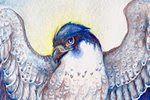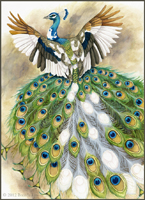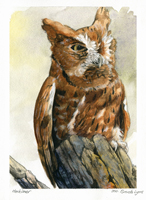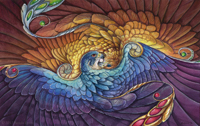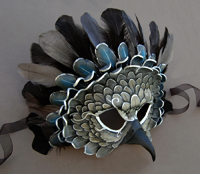Sketch and reference
Instead of using photo reference for the various conifers in this painting, I went out and collected a few from my very own winter wonderland. A nearby park had plenty of spruce, cedar and pine boughs for me to take samples of, as well as plenty of acorns on the ground. Painting from life, even if you're not painting the object exactly, will always help you achieve a more realistic object. Even having a spruce clipping in front of you will help you get a 'feel' for the plant as you paint.
Painting the Conifers
Having different types of plants in front of you also helps you compare colors between, say, spruce and cedar. The spruce was much more blue than the cedar, which was more of a dull green. Oxide of Chromium is one of those greens which was collecting dust in my watercolor collection, as I tend to favor more vibrant greens, such as Sap Green and Hooker's Green. Oxide of Chromium is one of those gray greens that doesn't get nearly enough appreciation, but is often just the right compliment to a forest scene. Mixed with Moonglow (a purplish Daniel Smith color), I was able to achieve shadows that weren't so blue or vibrant to kill the subtle tone of the green.
For the spruce branches on the right of the painting, I used Pthalo Green with Prussian Blue for the shadows. I needed to paint each needle, to avoid ending up with a green sky, which I painted then with Indigo and a wash of Dioxazine Violet. For the spruces closer to the warm candlelight on the left, I used Hooker's Green for the brightest branches.
Base Shadows
Solstice has rich gold and reddish gold plumage on her outer wings, with soft cream and brown feathers on her belly and inner wings. For the shadows I used a little Moonglow mixed with Raw Umber on the inner wings and belly. For her outer wings, I used Moonglow with a little Van Dyke Brown. Since her back was to be in shadow, I used dark blues such as Prussian Blue, mixed with a little Ultramarine for her neck and head feathers. From neck to front, I gradually switched from deeper to lighter washes of Moonglow.Don't be afraid to use blue shadows for orange objects, such as the fox. If the light/shadow separation is dramatic, such as in a night scene lit by candles, your shadows will be blue or purple. Painting a wash of orange over this will create a naturalistic shadow.
First Washes
After working on the shadows a bit, I started painting in washes. For the slight gradation of the reddish brown feathers, I used a simple wash of Quinacridone Deep Gold (another Daniel Smith mixture) and started at the bottom of each feather, painting up. Naturally you will begin to lose pigment the more you paint up, so the result was a natural gradation. You can also do this by painting dark pigment at the bottom, then rinsing the paint off your brush, and pulling the wet paint up with a wet brush. Either method works!
For the buff coloration of the belly and face, I used very light washes of Naples Yellow, with a little Raw Umber. I used more Naples Yellow closer to the candle. Candles are a bit tricky to paint, since you naturally want to go darker the farther from the flame you are. Remember though - the light from the flame travels through the candle and illuminates it a bit, so be sure not to go too dark when painting close to the flame.
Details
Painting feather details is one of my biggest joys! I added another wash of Quinacridone Deep Gold to darken the feathers, adding a little Yellow Ochre at the top of each feather to add a bit of yellow. Once dry, I added the bars with a mixture of Van Dyke Brown and Sepia. The inner feather bars are a light wash of Van Dyke Brown and Raw Umber. At this point, the painting is nearly done, except for the cardinals, fox, small candles, and the branches over the wing.
Final Painting
As you can see, the blue on the back of the fox and the back wing of the gryphon don't take away from the orange-brown of the fur and feathers. It creates a sense of deeper warmth on the side being illuminated. A few very light washes with Cadmium Yellow on the trees surrounding the candles helps brighten up the scene.





























